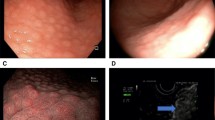Abstract
Background and Aims
Chemokine CXC ligand 13 (CXCL13) and CXC receptor type 5 (CXCR5) are constitutively expressed in tertiary lymphoid follicles where the CXCL13/CXCR5 system regulates B lymphocytes homing. In this study, we sought to examine CXCL13 expression in the H. pylori-infected and -uninfected gastric mucosa and to elucidate the implication in the pathogenesis of HAG in humans.
Methods
Using endoscopic biopsies taken from the gastric antrum of 29 subjects infected with Helicobacter pylori and 22 uninfected subjects, mucosal CXCL13 mRNA and protein levels were measured by real-time polymerase chain reaction and enzyme-linked immunosorbent assay, respectively.
Results
The CXCL13 expression levels were significantly more elevated in H. pylori-positive patients than uninfected ones. The CXCL13 expression levels correlated with the degree of chronic gastritis and bacterial colonization. Immunohistochemistry and in vitro infection assay showed that CXCL13 was not produced by the gastric epithelium, but the α-smooth muscle antigen expressing mesenchymal cells were the possible source of CXCL13 within H. pylori-infected gastric mucosa. CXCR5 immunostaining was seen in the CD20-positive lymphoid aggregates.
Conclusions
The enhanced induction of CXCL13 may be involved in the pathogenesis of H. pylori-associated gastritis.







Similar content being viewed by others
References
Blaser MJ, Atherton JC. Helicobacter pylori persistence: biology and disease. J Clin Invest. 2004;113:321–333.
Ernst PB, Gold BD. The disease spectrum of Helicobacter pylori: the immunopathogenesis of gastroduodenal ulcer and gastric cancer. Annu Rev Microbiol. 2000;54:615–640.
Allen LAH. The role of the neutrophils and phagocytosis in infection caused by Helicobacter pylori. Curr Opin Infect Dis. 2001;14:273–277.
Shimoyama T, Crabtree JE. Bacterial factors and immune pathogenesis in Helicobacter pylori infection. Gut. 1998;43:S2–S5.
Zevering Y, Jacob L, Meyer TF. Naturally acquired human immune responses against Helicobacter pylori and implications for vaccine development. Gut. 1999;45:465–474.
Baggiolini M. Chemokines and leukocyte traffic. Nature. 1998;392:565–568.
Luster AD. Chemokines–chemotactic cytokines that mediate inflammation. N Engl J Med. 1998;338:436–445.
Isomoto H, Mizuta Y, Miyazaki M, et al. Implication of NF-kappaB in Helicobacter pylori-associated gastritis. Am J Gastroenterol. 2000;95:2768–2776.
Hansson M, Hermansson M, Svensson H, et al. CCL28 is increased in human Helicobacter pylori-induced gastritis and mediates recruitment of gastric immunoglobulin A-secreting cells. Infect Immun. 2008;76:3304–3311.
Nishi T, Okazaki K, Kawasaki K, et al. Involvement of myeloid dendritic cells in the development of gastric secondary lymphoid follicles in Helicobacter pylori-infected neonatally thymectomized BALB/c mice. Infect Immun. 2003;71:2153–2162.
Wu YY, Tsai HF, Lin WC, et al. Upregulation of CCL20 and recruitment of CCR6+ gastric infiltrating lymphocytes in Helicobacter pylori gastritis. Infect Immun. 2007;75:4357–4363.
Tomimori K, Uema E, Teruya H, et al. Helicobacter pylori induces CCL20 expression. Infect Immun. 2007;75:5223–5232.
Yoshida A, Isomoto H, Hisatsune J, et al. Enhanced expression of CCL20 in human Helicobacter pylori-associated gastritis. Clin Immunol. 2009;130:290–297.
Gunn MD, Ngo VN, Ansel KM, et al. A B-cell-homing chemokine made in lymphoid follicles activates Burkitt’s lymphoma receptor-1. Nature. 1998;391:799–803.
Zlotnik A, Morales J, Hedrick JA. Recent advances in chemokines and chemokine receptors. Crit Rev Immunol. 1999;19:1–47.
Legler DF, Loetscher M, Roos RS, et al. B cell-attracting chemokine 1, a human CXC chemokine expressed in lymphoid tissues, selectively attracts B lymphocytes via BLR1/CXCR5. J Exp Med. 1998;187:655–660.
Schaerli P, Willimann K, Lang AB, et al. CXC chemokine receptor 5 expression defines follicular homing T cells with B cell helper function. J Exp Med. 2000;192:1553–1562.
Nakajima T, Amanuma R, Ueki-Maruyama K, et al. CXCL13 expression and follicular dendritic cells in relation to B-cell infiltration in periodontal disease tissues. J Periodontal Res. 2008;43:635–641.
Schiffer L, Kümpers P, Davalos-Misslitz AM, et al. B-cell-attracting chemokine CXCL13 as a marker of disease activity and renal involvement in systemic lupus erythematosus (SLE). Nephrol Dial Transplant. 2009;24:3708–3712.
Carlsen HS, Baekkevold ES, Johansen FE, et al. B cell attracting chemokine 1 (CXCL13) and its receptor CXCR5 are expressed in normal and aberrant gut associated lymphoid tissue. Gut. 2002;51:364–371.
Winter S, Loddenkemper C, Aebischer A, et al. The chemokine receptor CXCR5 is pivotal for ectopic mucosa-associated lymphoid tissue neogenesis in chronic Helicobacter pylori-induced inflammation. J Mol Med. 2010;88:1169–1180.
Mazzucchelli L, Blaser A, Kappeler A, et al. BCA-1 is highly expressed in Helicobacter pylori-induced mucosa-associated lymphoid tissue and gastric lymphoma. J Clin Invest. 1999;104:R49–R54.
Dixon MF, Genta RM, Yardley JH, et al. Classification and grading of gastritis. The updated Sydney System. International Workshop on the histopathology of gastritis. Houston 1994. Am J Surg Pathol. 1996;20:1161–1181.
Isomoto H, Ueno H, Saenko VA, et al. Impact of Helicobacter pylori infection on gastric and plasma ghrelin dynamics in humans. Am J Gastroenterol. 2005;100:1711–1720.
Segerer S, Schlöndorff D. B cells and tertiary lymphoid organs in renal inflammation. Kidney Int. 2008;73:533–537.
Galamb O, Gyõrffy B, Sipos F, et al. Helicobacter pylori and antrum erosion-specific gene expression patterns: the discriminative role of CXCL13 and VCAM1 transcripts. Helicobacter. 2008;13:112–126.
Matsushima K, Isomoto H, Inoue N, et al. MicroRNA signatures in Helicobacter pylori-infected gastric mucosa. Int J Cancer. 2011;128:361–370.
Conflict of interests
All authors declare that there are no conflicts of interest.
Author information
Authors and Affiliations
Corresponding author
Rights and permissions
About this article
Cite this article
Nakashima, Y., Isomoto, H., Matsushima, K. et al. Enhanced Expression of CXCL13 in Human Helicobacter pylori-Associated Gastritis. Dig Dis Sci 56, 2887–2894 (2011). https://doi.org/10.1007/s10620-011-1717-8
Received:
Accepted:
Published:
Issue Date:
DOI: https://doi.org/10.1007/s10620-011-1717-8




